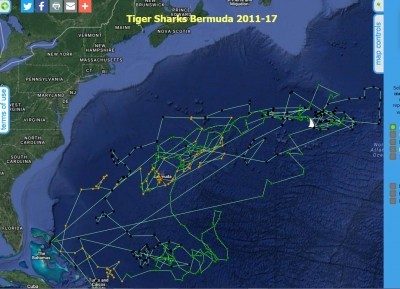NSU Newsroom
SharkBytes
Horizons
This version of NSU News has been archived as of February 28, 2019. To search through archived articles, visit nova.edu/search. To access the new version of NSU News, visit news.nova.edu.
This version of SharkBytes has been archived as of February 28, 2019. To search through archived articles, visit nova.edu/search. To access the new version of SharkBytes, visit sharkbytes.nova.edu.
NSU Research Spotlight: NSU’s Guy Harvey Research Institute Tagged Tiger Shark Breaks Distance Record – And Is Still Going!
A tiger shark named “Andy” is like the marine version of the Energizer Bunny – he keeps going and going and going…
Andy, tagged in Bermuda in 2014 by Nova Southeastern University’s (NSU) Guy Harvey Research Institute (GHRI,) has broken the record for distance traveled by a GHRI tagged shark, covering 33,820 miles in just over three years (1,113 days.)
NSU’s GHRI has an extensive history of tagging sharks with satellite tags to study their migration patterns and interactions with fisheries. To date, more than 150 tiger, mako and oceanic whitetip sharks have been tagged with satellite tags around the world by GHRI researchers but Andy has surpassed them all.
The satellite tags used in this study report a shark’s location every time the dorsal fin breaks the surface of the water. Because tiger sharks spend less time on the surface than other species, the battery in their tags tends to last longer than other tagged sharks, including makos.
“We have had satellite tagged mako sharks go on some very impressive treks around the Atlantic but the batteries in those tags tend to run out after a year or two since makos go to the surface and report very frequently,” said GHRI director Mahmood Shivji, Ph.D. “Tiger sharks report less often, but in return have provided the longest time and distance tracks – and Andy is the new distance champion.”
Shivji is also a professor in NSU’s Halmos College of Natural Sciences and Oceanography, and the director of the Save Our Seas Shark Research Center.
Named after the angler who caught the shark for tagging, Andy has continued to add to the knowledge base of these wide-ranging animals and is still reporting from far out in the Atlantic, near the mid-Atlantic Ridge. Andy and all NSU GHRI tagged sharks can be followed online in near real-time at nova.edu/sharktracking.
“To have a shark report for such a long time is providing invaluable data for researchers,” said world renowned artist and Guy Harvey Ocean Foundation (GHOF) Chairman Guy Harvey, Ph.D. “Knowing where these animals travel year after year allows us to see annual patterns and migration routes. This knowledge is fundamental to managing the species.”
NSU’s GHRI western North Atlantic Ocean tiger shark study has shown definitive, seasonal migration paths of tiger sharks between Bermuda and the Bahamas. These findings, along with input from the Bahamas National Trust and Pew Charitable Trusts, were integral to proving the value of Bahamian waters to Atlantic tiger shark populations and compelled the Government of the Bahamas in 2011 to declare their federal waters a shark sanctuary, prohibiting the commercial harvesting of sharks.
